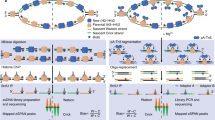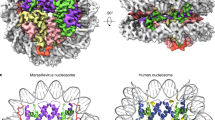Abstract
MITOCHONDRIAL DNA possesses ribonucleotide linkers1–3 and although double-stranded eukaryotic chromosomal DNA seems to be continuous throughout the length of the chromosome4 it is possible that single-stranded DNA possesses physical (nicks) or chemical (non-deoxynucleotide linkers) discontinuities. To distinguish between an in vivo nick and a nick introduced by shear forces during DNA extraction is very difficult with the presently available techniques. The detection of non-deoxynucleotide linkers is, however feasible, providing that denatured DNA can be sedimented in a chemical environment in which the linker is not destroyed. In these conditions, the comparison between sedimentation profiles of DNA, previously treated or not with a reagent that attacks the linker, may reveal the discontinuity. An obvious such reagent is a strong base, thus precluding the use of alkaline gradients in these experiments, and so we have attempted to use sucrose gradients in non-aqueous formamide. In addition, the DNA had to be extracted by a very gentle method in order to keep its average molecular weight in the range of 50–80 × 106. Using these conditions, we were able to detect alkali-sensitive linkers in chromosomal DNA of green monkey kidney cells.
This is a preview of subscription content, access via your institution
Access options
Subscribe to this journal
Receive 51 print issues and online access
$199.00 per year
only $3.90 per issue
Buy this article
- Purchase on Springer Link
- Instant access to full article PDF
Prices may be subject to local taxes which are calculated during checkout
Similar content being viewed by others
References
Grossman, L. I., Watson, R. & Vinograd, J. Proc. natn. Acad. Sci. U.S.A. 70, 3339–3443 (1973).
Miyaki, M., Koide, K. & Ono, T. Biochem. biophys. Res. Commun. 50, 252–258 (1973).
Wong-Staal, F., Mendelsohn, J. & Goulian, M. Biochem. biophys. Res. Commun. 53, 140–148 (1973).
Kavenoff, R. & Zimm, B. H. Chromosoma (Berl.) 41, 1–27 (1973).
Huberman, J. A. & Riggs, A. D. J. molec. Biol. 32, 327–341 (1968).
Lehmann, A. R. J. molec. Biol. 66, 319–337 (1972).
Brutlag, D., Schekman, R. & Kornberg, A. Proc. natn. Acad. Sci. U.S.A. 68, 2826–2829 (1971).
Sugino, A. & Okasaki, R. Proc. natn. Acad. Sci. U.S.A. 70, 88–92 (1973).
Magnusson, G., Pigiet, V., Winnacker, E. L., Abrams, R. & Reichard, P. Proc. natn. Acad. Sci. U.S.A. 70, 412–415 (1973).
Lindahl, T. & Nyberg, B. Biochemistry 11, 3610–3618 (1972).
Hozier, J. C. & Taylor, J. H. J. molec. Biol. 93, 181–201 (1975).
Fujiwara, Y. Cancer Res. 35, 2780–2789 (1975).
Hershey, H. V. & Werner, D. Nature 262, 148–150 (1976).
Meneghini, R. Biochim. biophys. Acta 425, 419–427 (1976).
Studier, F. W. J. molec. Biol. 11, 373–390 (1965).
Author information
Authors and Affiliations
Rights and permissions
About this article
Cite this article
FILIPPIDIS, E., MENEGHINI, R. Evidence for alkali-sensitive linkers in DNA of African green monkey kidney cells. Nature 269, 445–447 (1977). https://doi.org/10.1038/269445a0
Received:
Accepted:
Issue Date:
DOI: https://doi.org/10.1038/269445a0
This article is cited by
-
The mechanism of C-banding: depurination and ?-elimination
Chromosoma (1979)
Comments
By submitting a comment you agree to abide by our Terms and Community Guidelines. If you find something abusive or that does not comply with our terms or guidelines please flag it as inappropriate.



